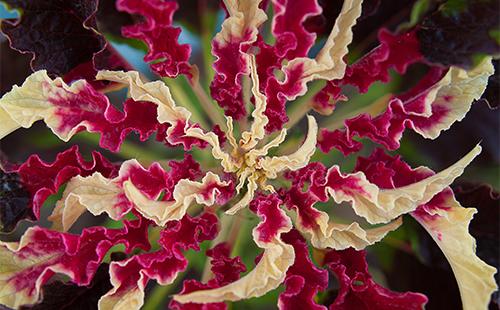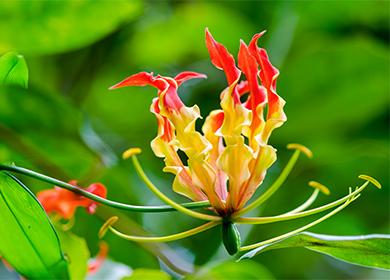The content of the article
Initially, it belonged to the Lilein family, but now it belongs to the Bezrevremennikovs. The culture is characterized by rapid growth and unusual colors. To make her happy for many years, it is important to ensure proper and regular care.
Description and types
Gloriosa is a perennial with bright green lanceolate leaves and curly shoots. Its maximum height is 5 m. Each flower is attached to a long peduncle. Liana blooms with unusual two-tone flowers, similar to a lily. The main colors are red and yellow in different shades. When the buds open and are blown by the wind, they resemble a flame of fire. Wavy petals give the plant even more sophistication.
Starting from the moment of flowering, gradually changes color. The appearance of the flower and the features will vary depending on its type. The most popular of them are the following.
- Citrine Flowers of a lemon shade with stains of dark red color.
- Simple. It grows in Africa in tropical forests. The length of the culture reaches 1.5 m. Leaves with pointed ends of oblong shape. Yellow-green petals with reddish stains. Flowering occurs in the summer.
- Luxurious. It is considered the most famous species of gloriosa. It grows in tropical forests with high humidity and clay soil. The maximum shoot length is 2 m. Lanceolate leaves grow three in succession, pointed at the end. It blooms from early June to late August. This species is divided into subspecies: yellow and Carson. The first has lemon yellow flowers. The second is distinguished by buds, the middle of the petals of which is painted in a chocolate-violet hue, and the edge is in lemon yellow.
- Rothschild. Most often found in the tropics of Africa with high humidity. Branched shoots, curly. Leaves of a lanceolate form. Single flowers located in the axils of foliage. Their petals are beautiful wavy look saturated red or red-crimson hue. The lower part of the bud with yellow-red spots. Flowering is observed from the beginning of spring to the beginning of autumn.
- Grena. One of the most unusual species. Flower petals are smooth and undulating. They are yellow-lemon in color and bent to the peduncle in the shape of an arc. Due to this structure, the flower resembles a Chinese lantern.
- Modest. A common variety that grows in South Africa. It grows up to 2 m. Foliage of a lanceolate-ovoid form. Bell-shaped orange-yellow flowers with smooth petals.
Basic care
To flower pleased for many years and bloomed well, you need to provide him with the most comfortable conditions for growth.
- Lighting. The plant should be in a place where there is no direct sunlight in the hot season. It is best placed on window sills that face west or east. Direct exposure to the sun negatively affects flowering. In the spring, the culture is accustomed to the sun's rays gradually so that burns do not appear. It is better to make artificial lighting.
- Temperature. The most optimal temperature indicators are 20-25 ° C.In winter, the flower is at rest. At this moment, the upper stems die off and only tubers remain that need to be dug up and sprinkled with sand. Wintering should be carried out at a temperature of about 10 ° C. Watering at this time is minimal or completely absent. It is necessary to protect the culture from drafts. In spring, when shoots begin to appear, the temperature gradually increases.
- Air humidity. In winter, when the heating is turned on, and in summer, when the air is very dry and hot, for the pot you need to prepare a pallet with moss or pebbles soaked in water. Humidity should be within 80%. In addition, you need to spray the leaves with purified water. Buds cannot be moistened.
- Watering. At the time of flowering, culture needs good watering. Protected or rain water is suitable. The frequency of soil moisture can be determined by its upper layer. It should dry by 1 cm. When autumn comes, watering is reduced, and then completely stops. With insufficient watering, the tips of the leaves dry in the plant.
Transfer
The flower feels good in the soil, which contains leafy soil and humus in a ratio of 1: 2. You also need to add some peat or sand. Gloriosa is transplanted every year in early spring, until the buds are formed. Some people prefer to do this at the end of February. The soil should be slightly acidic, with a pH value of 6.
For transplantation, not deep, but wide ceramic pots are chosen. Pebbles are laid on the bottom of the tank (1/4), then soil is added. The tuber is transplanted to a depth of about 3 cm. The soil must be watered and contain the culture at a temperature of about 20 ° C. The first shoots adapt to the light gradually. Also, they need to be watered heavily.
Post transplant
The culture is growing very intensively. She is transplanted into another pot along with the earthen lump in which she grew up, adding a little new substrate. Watering is possible only two days after transplanting.
Liana needs to be tied up from the moment the first young shoots appear. You can use small reeds and thin wire. When the flower becomes more massive, you can use a reinforced frame.
The active growth period is in May-June. At this point, the height of the culture reaches about 1-2 m. For aesthetics, the stem can be slightly bent down.
Closer to autumn, the plant makes it yellow and dry, which indicates the onset of a dormant period. At this time, watering is reduced. Tubers can be left in a pot, which is stored in a dark place at a low temperature. In early spring, they are dug up and planted in new soil. You can also dig up tubers immediately upon the onset of the rest period by placing them in a box with peat. The box is tightly closed and placed in a place where the temperature is not higher than 12 ° C.
Breeding
The propagation of gloriosa can be performed both by seed and by division of tubers. The second option is considered the most convenient and fast.
- Division of tubers. Soil for young flowers should consist of sod, leaf and humus soil and sand. Propagated in spring. The tuber is divided into several parts with a sharp knife. Cut points are sprinkled with coal powder. If children appear in the root system, they must be separated and planted in new small pots with a diameter of 13-16 cm. The tuber should be covered with earth at the level of 3 cm, and the growth point of the culture is directed upwards. It is necessary to provide temperature indicators of 22-24 ° C.Watering should begin after the emergence of young shoots. Weak stems to make support from small rods and gently tie them up. When there are more plants, you can transplant.
- The seeds. You can try to get young seedlings from the seed. But it takes more time and patience. At the time of flowering, it is necessary to take a cotton bud and perform self-pollination. This will allow you to get seeds that are placed in the ground immediately after ripening. The substrate should consist of sand, peat and sod land. Temperature indicators in the range of 22-25 ° C. Watering is moderate. The lack of plants grown from seed - the onset of flowering only three years after planting.
Disease
The most common crop diseases are as follows.
- Powdery Mildew On the surface of leaves and buds, a white coating appears. It leads to yellowing of the foliage and its drying. New leaves grow deformed. To cope with the problem, pruning heavily affected foliage and buds will help. Every day, the culture must be sprayed with a solution of laundry soap and soda ash. You also need to water the soil with drugs such as Vectra, Topaz, or a combination of Streptomycin with Penicillin and Terramycin.
- Root rot. Petioles of leaves and shoots at the base become slippery, the smell of rot appears. Affected parts of the culture are easily separated from it. An urgent need to transplant gloriosa, after removing all the affected parts. In the new earth add "Glyocladin" or "Trichodermin." Over a week, watering should be carried out using a solution of Bordeaux fluid and copper sulfate. Alirin-B and Previkur funds are also suitable.
- Gray rot. On the surface of the foliage and stem, gray-brown volume spots with black spots are formed. It is necessary to cut off all the damaged parts, then transplant the culture into new soil and a pot. Spray with a solution of Fundazole every day.
Pests
Gloriosa can be affected by various pests, among which the aphids, scale insects and spider mites are the most common.
- Shield. Yellow-red spots appear on the surface of the plant near the rapidly growing grayish tubercles. An unnatural black shade of earth in the pot is also observed. It is necessary to lubricate the formation on the surface of the plant with vinegar, then apply a soap solution and after 20 minutes rinse it under water. Every day you need to apply gruel from onions and garlic or preparations with oil to the problem areas. Also spraying with "Fosbetsidom".
- Spider mite. It leads to the appearance of not only cobwebs, but also spots on the leaves. It can be removed with a cotton pad soaked in alcohol and “Aktofit” or “Anticlesch” preparations.
- Aphid. Forms small dots of beige shade and a sticky coating on the foliage. It is necessary to cut off heavily affected parts of the culture, then spray up to three times a day with infusions from plant materials, which have a strong aroma. It can be orange peel, mustard powder, needles. Kinmix or Arrivo is also used.

Violation of the conditions of detention
If you do not provide the plant with proper conditions of detention, then this will lead to unpleasant changes:
- white plaque on the leaves - high humidity or lack of moisture in the soil;
- lack of young foliage and buds - insufficient light or damaged root system;
- lethargy and darkening of leaves - sudden changes in temperature;
- yellowness and drying of leaves- lack of moisture.
You need to fertilize the culture with both mineral and organic fertilizing, alternating them. Enough twice a month, from spring to flowering. Suitable remedies for flowering indoor plants.

